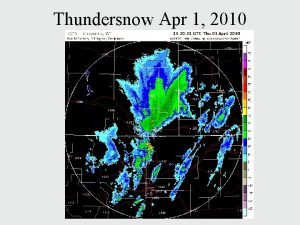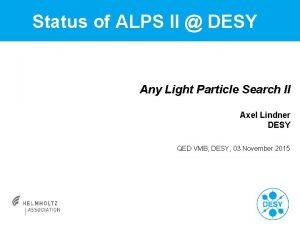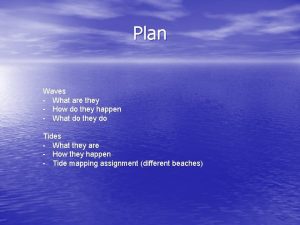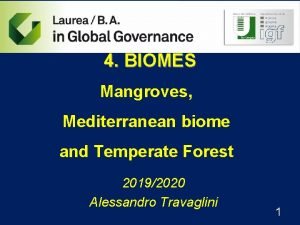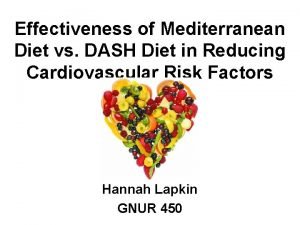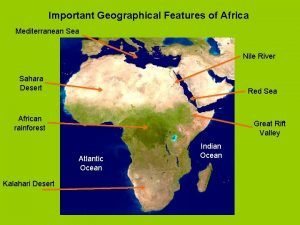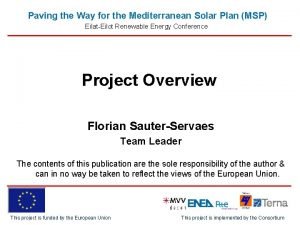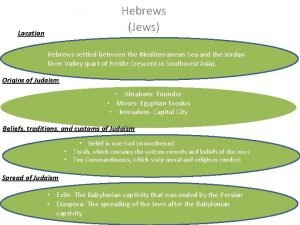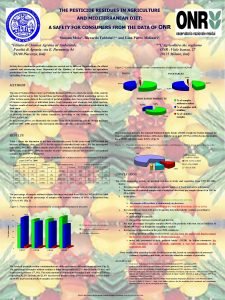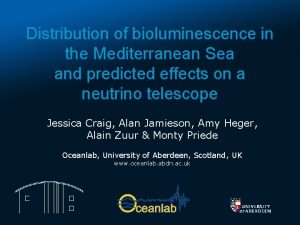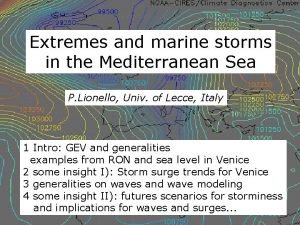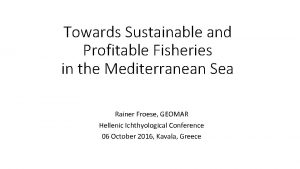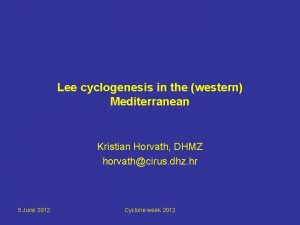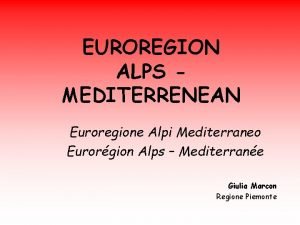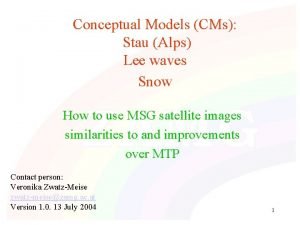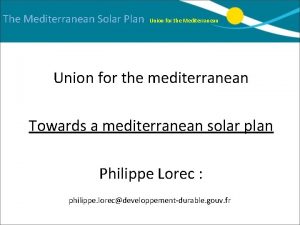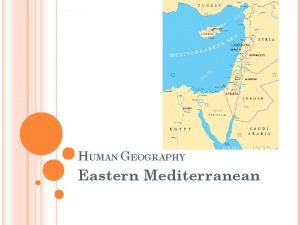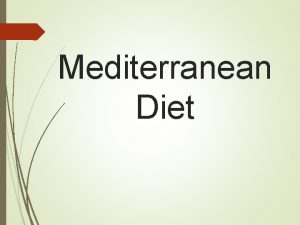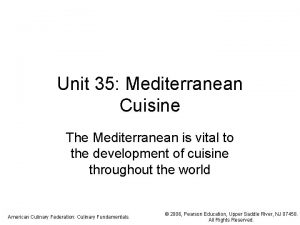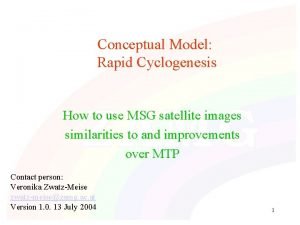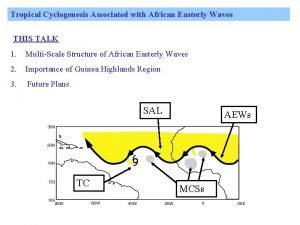Mediterranean Lee Cyclogenesis The influence of the Alps







































- Slides: 39

Mediterranean Lee Cyclogenesis The influence of the Alps on the development of a symmetric, warm-core subsynoptic cyclone during MAP D-PHASE (15 -16 November 2007) Ron Mc. Taggart-Cowan 1 and Tom Galarneau Jr. 2 1 Environment Canada 2 University at Albany

Outline Review of lee cyclogenesis mechanisms: Barotropic vortex shedding PV streamer generation Normal mode baroclinic growth Analysis of 15 November 2007 lee cyclone Forecast model (CMCGEML/CMCGEMH) development of lee cyclone Attribution integrations with modified orography Discussion

Background Review of Lee Cyclogenesis Lee Cyclones: Flow splitting around terrain induces vortex shedding (Krishnamurti 1968) Cross-barrier pressure/temperature perturbation creates a surface PV anomaly as front “hangs up” on the Alpine block (Bleck and Mattocks 1984) Mesoscale concentration of vorticity in PV banners (Aebischer and Schar 1998) Normal mode baroclinic growth (Buzzi and Speranza 1986) 1330 UTC 16 Jan 1995 Courtesy of J. Beven and Meteo. Sat Mediterranean “Hurricanes”: Axisymmetric structure with convectivelygenerated warm core and WISHE-triggering winds

Case Study 15 -16 November Rapid Subsynoptic Cyclogenesis Strong northerly flow across the Alps on 15 November during trough / front passage and cutoff C Streamfunction and nondivergent wind at 500 h. Pa computed from the 0. 5 o GFS final analysis. Extent of snow cover is shown by grey shading. Short, long and pennant wind barbs represent wind speeds of 2. 5, 5 and 25 ms-1, respectively.

Case Study 15 -16 November Rapid Subsynoptic Cyclogenesis Orographic blocking of cold air leads to a large cross-Alpine pressure gradient SLP (every 2 h. Pa) (every 2 C) Analysis of surface observational data for 1200 UTC 15 November. Isobars at 2 h. Pa intervals are plotted with solid blue lines, and surface potential temperatures at 2 K intervals are Spain plotted with dashed red lines. Cold ∆P Switzerland Warm Italy Sardinia Sicily Analysis Valid 1200 UTC 15 November 2007

Case Study 15 -16 November Rapid Subsynoptic Cyclogenesis Vortex develops on cyclonic shear side of Mistrals in strong confluent frontogenesis SLP (every 2 h. Pa) (every 2 C) Analysis of surface observational data for 1200 UTC 15 November. Isobars at 2 h. Pa intervals are plotted with solid blue lines, and surface potential temperatures at 2 K intervals are Spain plotted with dashed red lines. Analysis Valid 1200 UTC 15 November 2007 Switzerland Italy Mistral L Sardinia Sicily

Case Study 15 -16 November Rapid Subsynoptic Cyclogenesis Meteo. Sat visible satellite image for 0800 UTC 16 November 2007. Cyclone develops an axisymmetric warm core structure as the remnant front progresses eastward Quick. Scat retrieved wind speed (colour bar) and vectors (black arrows) for morning 16 November Cyclone sustains hurricane-force surface winds of (30 ms-1) by 0000 UTC 16 November

Model Description CMCGEML/CMCGEMH (15 / 2. 5 km) driven by GEM global (35 km) ICs/BCs for 18 h forecasts Inner grid shifted slightly southward to better position the cyclone of interest Microphysical parameterization updated to correct problems noted during D-PHASE Orography growth (as implemented in MC 2 following original MAP campaign) over 6 -h in CMCGEML and 4 -h in CMCGEMH Shifted CMCGEMH domain

Control Forecast Evaluation of Control Forecast Coherent tropopause disturbance (CTD) at the base of the trough moves across the Alps Lower level vorticity is generated by Alps and horizontal shear zone CTD 00 -h 00 Z/15 CTD is fragmented as convection is triggered over the warm Mediterranean waters Resulting cyclone has spiral vorticity structure 36 -h 00 Z/15 24 -h 00 Z/15 Dynamic Tropopause (DT) potential temperature (as indicated on the greyscale) and winds (knots), and 925850 h. Pa layer-average relative vorticity (magenta contours > 2 x 10 -4 s-1 at 4 x 10 -4 s-1 intervals) from the control forecast.

Attribution Testing Attribution Test: Alpine Removal Alpine orography is relaxed to a regional average during spinup to avoid initial shock Cyclone develops over Corsica (east of position in the control forecast) Intensity and final cyclone location are similar in control forecast and “Alps” attribution test Curvature component of vorticity (x 104 s-1) for the control forecast and attribution tests as indicated in the legend.

Attribution Testing Attribution Test: Alpine Removal Trough and CTD remain essentially unaffected by the removal of the Alpine barrier over this short time scale Despite the dramatic nature of the modifications, a subsynoptic cyclone develops in the Gulf of Genoa Control Forecast 24 -h 00 Z/15 Alpine Removal Test 24 -h 00 Z/15 DT potential temperature and winds, and 925 -850 h. Pa relative vorticity, as in previous figures.

Attribution Testing Attribution Test: Alpine Removal Trough and CTD remain essentially unaffected by the removal of the Alpine barrier over this short time scale Despite the dramatic nature of the modifications, a subsynoptic cyclone develops in the Gulf of Genoa “Lee” cyclogenesis proceeds without the Alps, suggesting that the atmosphere was already primed for subsynoptic cyclogenesis before 0000 UTC 15 November. Did the Alps contribute to this preconditioning?

Attribution Testing Attribution Test: To-12 h Control forecast system is rerun from analyses 12 h earlier (1200 UTC 14 November 2007) Trough progresses southward more rapidly and triggers development before the CTD reaches the Mediterranean Cyclone develops further east, but near the observed time Control Forecast 12 -h 00 Z/15 To-12 h Control Forecast 24 -h 12 Z/14 DT potential temperature and winds, and 925 -850 h. Pa relative vorticity, as in previous figures.

Attribution Testing Attribution Test: To-12 h Control forecast system is rerun from analyses 12 h earlier (1200 UTC 14 November 2007) Trough progresses southward more rapidly and triggers development before the CTD reaches the Mediterranean Cyclone develops further east, but near the observed time Control Forecast 24 -h 00 Z/15 To-12 h Control Forecast 36 -h 12 Z/14 DT potential temperature and winds, and 925 -850 h. Pa relative vorticity, as in previous figures.

Attribution Testing Attribution Test: To-12 h Alpine Removal Large-scale upper level structure is notably modified from To-12 h control The CTD is unable to couple with a lowerlevel PV perturbation for development and begins to decay To-12 h Control Forecast 36 -h 12 Z/14 To-12 h Alpine Removal Test No cyclone forms in the Gulf of Genoa 36 -h 12 Z/14 DT potential temperature and winds, and 925 -850 h. Pa relative vorticity, as in previous figures.

Attribution Testing Attribution Test: To-12 h Alpine Removal Large-scale upper level structure is notably modified from To-12 h control The CTD is unable to couple with a lowerlevel PV perturbation for development and begins to decay No cyclone forms in the Gulf of Genoa Alpine modification to the local flow was crucial to establishing a favourable environment between 1200 UTC 14 and 0000 UTC 15 November What mountain-induced element was the key to preconditioning?

Attribution Testing Alpine Influence on Development Comparison of the 12 h forecast from the To-12 h Alpine Removal and the control initialization shows a large thickness difference Alpine blocking holds back the cold front and creates a relative warm area in the lee Warm pool is a surface potential temperature anomaly (θ' ) Thickness (1000 -500 h. Pa) difference between the 12 h forecast of the To-12 h Alpine Removal and the initializing data for the control forecast (warm colours indicate areas where the control data is warmer). Control forecast thicknesses are plotted at 6 dam intervals with magenta contours. Anomaly inversion area is indicated by the blue box.

Attribution Testing Attribution Test: To-12 h Warm Pool PV inversion uses θ'sfc as a lower boundary constraint The balanced flow associated with θ'sfc in the northern Gulf is inserted into the 12 h forecast from the To 12 h Alpine Removal This attribution test isolates this single effect of the Alps Inverted θ'sfc (Kelvin, 0>K as indicated on the colour bar) and winds (yellow barbs in knots) at 1000 h. Pa, and zonal cross-section of potential temperature (1 K intervals as indicated on the greyscale) and meridional winds (blue contours in 1 kt intervals) as indicated on the plan view.

Attribution Testing Attribution Test: To-12 h Alpine Warm CTD moves further around the base of the trough and eastward before triggering convection Cyclone develops further east, between Cypress and Italy PV coupling occurs further east as a result of the displacement of the upper and lower level features To-12 h Control Forecast 36 -h 12 Z/14 To-12 h Warm Test 36 -h 12 Z/14 DT potential temperature and winds, and 925 -850 h. Pa relative vorticity, as in previous figures.

Attribution Testing Attribution Test: To-12 h Alpine Warm CTD moves further around the base of the trough and eastward before triggering convection Cyclone tracks beginning at first identifiable time, and ending at 0000 UTC 16 November 2007. Cyclone develops further east, between Cypress and Italy PV coupling occurs further east as a result of the displacement of the upper and lower level features Curvature component of vorticity (x 104 s-1) for the control forecast and attribution tests as indicated in the legend.

Attribution Testing Attribution Test: To-12 h Warm Pool CTD moves further around the base of the trough and eastward before triggering convection Cyclone develops further east, between Cypress and Italy PV coupling occurs further east as a result of the displacement of the upper and lower level features Alpine blocking of the crossbarrier flow developed a warm anomaly in the lee that acted as a lower-level PV feature capable of coupling with the upper-level CTD This effect is reproduced by inserting a similar anomaly in the absence of the Alps themselves

Discussion An intense, warm-core subsynoptic cyclone developed over the Gulf of Genoa during the MAP D-PHASE project Attribution tests involving Alpine removal show that the effects of the Alps during development were restricted to structural changes in the cyclone rather than intensity The lee-side warm anomaly generated by blocking was synthesized and shown to be sufficient to promote development

Discussion Alpine vortex shedding, normal mode growth and banner generation did not play a leading role in this case of lee cyclogenesis; however, The Alps preconditioned the atmosphere for subsynoptic cyclogenesis by blocking the flow during frontal passage, creating a surface θ anomaly that coupled with an upper-level CTD to promote rapid development

The END What are you doing, Dave? That was the END Dave. . . why don't you take a chill pill?

Attribution Testing Orographic Modifications Model orography and cyclone tracks (9 -18 h range, circle for genesis) for attribution tests

Attribution Testing Cyclone Track / Intensity Despite differing genesis locations and tracks, all test cases develop cyclones of varying strengths Removal of local orography and Apennines enhances vortex strength beyond the control

Attribution Testing Cyclone Energetics (Eddy APE) Proportional to mean V'T' Proportional to mean Q'T' Elimination of cold air damming allows for greater cold outflow over the western Mediterranean: Enhanced conversion of APE to eddy APE (left) Reduced stability in the cold northerly flow limits convective eddy APE generation (right)

Attribution Testing Cyclone Energetics (Eddy APE) V'T' > 0 18 h Control 18 h Alps 1000 -500 h. Pa thickness from attribution tests (colour shading as indicated on the colour bar) and 700 h. Pa winds as on previous figures. Elimination of cold air damming allows for greater cold outflow over the western Mediterranean: Enhanced conversion of APE to eddy APE Reduced stability in the cold northerly flow limits convective eddy APE generation (right)

Attribution Testing Cyclone Energetics (Eddy APE) 12 h Control Air/sea temperature difference (K, as indicated on the colour bar) after 12 h Alps of integra-tion. Q'T' < 0 Elimination of cold air damming allows for greater cold outflow over the western Mediterranean: Enhanced conversion of APE to eddy APE Reduced stability in the cold northerly flow limits convective eddy APE generation (right)

Attribution Testing Cyclone Energetics (EKE) Elimination of perturbing near-vortex orography allows for effective coupling (active PV “hook”), enhancing barotropic KE – EKE conversion (left) A strong thermally direct circulation in the Dry run effectively converts eddy APE to EKE (right)

Attribution Testing Cyclone Energetics (EKE) 18 h Control 18 h Alps, Mas, Pyr, Isl, Apen DT potential temperature from tests as indicated (colour shading as indicated on the colour bar) and DT winds as on previous figures. Elimination of perturbing near-vortex orography allows for effective coupling (active PV “hook”), enhancing barotropic KE – EKE conversion A strong thermally direct circulation in the Dry run effectively converts eddy APE to EKE

Discussion Summary Lee cyclone (Uberstromungs-type) forms along a confluence line at intersection of PV banners Orographic attribution study suggests that orography is not a necessary component: Control: mountain triggering of diabatically developed “Mediterranean hurricane” type Alps: rapid baroclinic development with strong air-sea temperature differences (polar low) Full removal: combined baroclinic and barotropic forcing with diabatic assistance to generate the strongest cyclone in the tests (polar low) Integrated suspended hydrometeor after 18 h of integration.

Discussion Conclusion The mountains are not a necessary condition. . . Alpine (and surrounding) orography modifies the morphology of the “lee cyclone” in this case by modifying the regional flow, but does so in the context of an atmosphere already pre-disposed to rapid sub-synoptic cyclogenesis.

Control Forecast Evaluation of Control Forecast Orographic blocking is well represented in the control Cold Warm Core structure is warm and axisymmetric Cyclone is isolated from thermal ridge (black dashed line) 1000 -500 h. Pa thickness (values as indicated on the colour bar) and near-surface winds (barbs as in previous figures)

Case Study 15 -16 November Rapid Subsynoptic Cyclogenesis Strong northerly flow across the Alps on 15 November during trough / front passage and cutoff Streamfunction and nondivergent wind at 500 h. Pa computed from the 0. 5 o GFS final analysis. Extent of snow cover is shown by grey shading. Short, long and pennant wind barbs represent wind speeds of 2. 5, 5 and 25 ms-1, respectively.

Case Study 15 -16 November Rapid Subsynoptic Cyclogenesis Strong northerly flow across the Alps on 15 November during trough / front passage and cutoff Streamfunction and nondivergent wind at 500 h. Pa computed from the 0. 5 o GFS final analysis. Extent of snow cover is shown by grey shading. Short, long and pennant wind barbs represent wind speeds of 2. 5, 5 and 25 ms-1, respectively.

Alpine Lee Cyclones Review of Mesoscale Cyclogenesis Strong cross-barrier flow, orographic cold frontal blocking and airstream split around the obstacle Warm air left in the lee acts as a boundary PV anomaly: cyclonic flow and pressure perturbation Mesoscale mechanisms concentrate PV: GW or friction-induced PV banners Convective redistribution of PV Convective coupling may enhance interaction with upper trough during baroclinic development

Polar Lows Review of Mesoscale Cyclogenesis Form in regions of strong surface baroclinicity, weak convective stability and strong surface fluxes in the presence of an upper-level trigger Moist processes are crucial for coupling smallscale upper disturbances with the surface vortex Strong Shear (3 x 10 s No Shear Growth rates larger 60 h 30 h than baroclinic -3 -1) Warm core forms by seclusional process Structure modified by environmental shear Total condensed water results from idealized IC modelling tests by Yanase and Niino (2007).

Mediterranean Hurricanes Review of Mesoscale Cyclogenesis Subsynoptic cyclones that are morphologically similar to Atlantic hurricanes: Axisymmetric structure (implies little baroclinicity) Initiated by baroclinic or orographic mechanism (TT) Intensity maintained by WISHE process (>10 ms-1) Image courtesy of J. Beven and Meteosat Warm core and eye form following traditional tropical pathway as RMW contracts during intense convection
 Cyclogenesis stages
Cyclogenesis stages Lake effect side
Lake effect side Alps connect
Alps connect Www.assignmentpoint.com
Www.assignmentpoint.com This breed originated in french alps
This breed originated in french alps Napoleon crossing the alps
Napoleon crossing the alps Frivololity
Frivololity Napoleon ingres
Napoleon ingres Asian landscape painting
Asian landscape painting Y no hai remedio khan academy
Y no hai remedio khan academy Europe the alps
Europe the alps The wedding poem analysis
The wedding poem analysis Was rome protected by the alps
Was rome protected by the alps Alps desy
Alps desy Physical features of northern ireland
Physical features of northern ireland Europe physical map danube river
Europe physical map danube river Anatomy of a wave
Anatomy of a wave Mediterranean forest
Mediterranean forest Veronica v picasso biografia
Veronica v picasso biografia What is dash diet definition
What is dash diet definition Mediterranean island nation
Mediterranean island nation Gianlucci
Gianlucci Africa mediterranean
Africa mediterranean Mediterranean solar plan
Mediterranean solar plan Mediterranean sea map
Mediterranean sea map Civilization
Civilization Unit 2 the united states and canada
Unit 2 the united states and canada The hebrews settled between the mediterranean sea and the
The hebrews settled between the mediterranean sea and the Chapter 13 section 1 mediterranean europe
Chapter 13 section 1 mediterranean europe Mediterranean diet pesticides
Mediterranean diet pesticides Chapter 16 eastern mediterranean answers
Chapter 16 eastern mediterranean answers Danube river physical map
Danube river physical map Ancel keys mediterranean diet
Ancel keys mediterranean diet Mediterranean diet pyramid
Mediterranean diet pyramid Car gurtus
Car gurtus What was life like for the jews in greek ruled lands
What was life like for the jews in greek ruled lands Bioluminescence mediterranean sea
Bioluminescence mediterranean sea Storms in the mediterranean sea
Storms in the mediterranean sea General fisheries commission for the mediterranean
General fisheries commission for the mediterranean Mediterranean civilizations location hemisphere
Mediterranean civilizations location hemisphere
